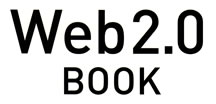 |
Web 2.0 Book
|
Cat: ICT |
Hiroshi Ogawa (小川浩) & Yasunari Goto (後藤康成) |
07909u/18214r |
Index
Key
Why?
- This "Web 2.0 Book" is a glossary of keywords and key concepts
of Web 2.0 related business.
- The book belt offers such expression as "Why Google, Amazon,
Apple are so cool?"
- この「Web 2.0 Book」はWeb 2.0に関連するビジネスのキーワードや概念を集めた本である。
- 本の帯には「Google, Amazon, Appleはなぜイケてる?」と書いてある。
Key
phrase
キーフレーズ
>Top
0. Introduction:
- The concept of Web 2.0 was not known as of Jan. 2006, but it
has been popular as of 2007 among IT and business people.
- The change caused by Web 2.0 would be compared to that of the
Cambrian explosion of 600 million years ago.
0.
序:
- Web 2.0の概念は2006年1月の時点では知られていなかったかが、2007年の時点ではITやビジネス業界では流行になった。
- Web 2.0のもたらす変化は、6億年前のカンブリア紀の変化に比べられるかも知れない。
>Top
1. Wave of Web 2.0:
- Web 2.0 means:
- this term does not represent a particular technology or
service.
- It is a term to indicate the second generation of Web environment:
a collection of big change and trend of Web-centric world.
- Tim O'Reilly proposed this term at the first "Web 2.0
Conference" in San Francisco in Oct. 2004.
- sometimes ridiculed as a buzzword.
- The trend of Web 2.0:
- Structured arrangement of contents on the Web, like a database-like
network.
- Java script and DHTML technology are called "Ajax"
- Web2.0 and XML:
- Web 2.0 is a high concentration of XML usage.
- Web 1.0 is difficult to connect A-site and B-site.
- XML is a programming language used for Web service.
- XHTML (eXtensible Hyper Text Markup Language)
- developed based on HTML 4.01, conforming to XML syntax.
- Permalink:
- Truckback
- RSS (Rich Site Summary, RDF Site Summary, or Really Simple
Syndication) (RDF=Resource Description Framework)
- Google AdSense: contextual advertising
- Web crawler, Web spider, or Web robot
- Semantic Web: Web as an autonomous database, understandable by
computers proposed by Tim Bernards-Lee.
- Background of Web 2.0: increase of users and volume of data by;
- Blog, SNS, Wiki, CMS (Xoops)
- Broadband environment
- Longtail phenomenon: Pareto's law
- Conditions of Web 2.0: defined by O'Reilly.
- Service provider: they are not package providers.
- Control of data source: 'Data inside' unlike 'Intel inside'
- Users' unconscious participation: utilizing feedback from
the users.
- Collective intelligence: making database of whole users.
- Longtail: business model targeting niche market.
- free from the platform: available on various OS and mobile.
- rich and light: mashup (Web application hybrid) using Ajax
or LAMP
- Information retrieval: Google, Yahoo, etc.
- Information/Intelligence sharing: Social bookmark, Social
tagging, Truckback
1. Web 2.0の波:
- Web 2.0の定義:
- 特定の技術やサービスは指さない。
- いわばWebの第二世代。
- Tim O'Reillyが、2004年10月の第1回Web 2.0カンファレンスで提唱。
- Web 2.0のトレンド:
- 構造化された配置、データベース的なネットワーク
- Java ScriptやDHML技術は"Ajax"と呼ばれて普及
- Web 2.0とXML:
- Web 2.0はXML利用濃度が高い
- Web 1.0ではAサイトとBサイトの連携が困難
- XMLはWebサービスで利用されるプログラム言語
- XHTML:
- HTML 4.01ベースに開発、XML文法に準拠
- Permalink
- Truckback
- RSS
- Google AdSense
- Web crawler, Web spider, Web robot
- セマンティックWeb: Web上の個別の情報を結びつけて一つの情報として機能する。
- Web 2.0の背景:
- Blog, SNS, Wiki, CMS (Xoops)
- Broadband環境
- Longtail現象
- Web 2.0の条件:O'Reillyの定義
- サービスプロバイダ
- データソースの管理
- ユーザの無意識な参加
- 集合知
- ロングテール現象:パレートの法則
- プラットフォームを選ばない
- リッチで軽い
- 情報検索
- 情報共有
-
Comparison of Web 1.0 vs. Web 2.0: by O'Reilly
Function
Web 1.0
Web 2.0
Ad
DoubleClick
Google AdSense
Photo sharing
Ofoto
Flickr
Contents distribution
Akamai
BitTorrent
Music share
MP3.com
Napster
Encyclopedia
Britannica.com
Wikipedia
Private HP
Private HP
Blog
Event management
evite
upcoming.org; EVDB
Business promotion
Domain name spec
SEO
Ad charges
Page view (PV)
CPC (Cost per click)
Contents collaboration
analysis by search engine
Web service
Contents creation
publishing
participation; CGM (Consumer Generated Media)
Contents management
CMS
Wiki
Contents classification
directory (taxonomy)
tagging (folksonomy)
Interoperability
connection to each Web site
Web syndication
>Top SEO (Search Engine Optimization:
- a process increasing access of the Web site by a search engine
to get higher ranking, like Google's page rank.
- Advent of blog and CGM (Consumer Generated Media):
- To understand blog is a fast way to understand Web 2.0.
- Blog changed structure of Web sites based on open standard
of XML using XHTML and RSS (or RSS feed).
- Truckback enables reciprocal link among Web sites
- Permalink is allocated in each article (=entry) written chronologically
in a blog.
- Blog is high-grade but easy to use (feature of Web 2.0)
- NetCloud???
SEO:
- Blogの台頭とCGM:
- Blogの理解はWeb 2.0の理解
- BlogはWebサイト構造をXML準拠に変えた
- TruckbackはWebサイトの相互リンクを可能に
- 時系列の記事 (entry)に対し、permalinkを割当
- 高度だが易しい(Web 2.0の特長)
>Top 2. From Web 1.0 to Web 2.0 :
- 1991. 8.6: The birth of Web:
- Tim-Bernards-Lee: concept of hypertext, HTTP, HTML, URL
- Unilateral connection: non-structural
- Development of Browser:
- Maac Andreesen: Mosaic at NCSA of Illinois Univ.
- Netscape Communications:
- Netscape Navigator
- SSL (Secured Socket Layer
- RSS
- Browser War:
- MS Internet Explorer + Windows95
- Netscape Communication: Merged into AOL
- Mozilla Corporation:
- Firefox: OSS browser
- Advent of Portal site:
- Yahoo!; directory type search
- netsurfing
- robot searching: crawler, spider
- banner Ad
- last half of 1990s:
Destination site: Portal site with own contents
- Yahoo!
- MSN
- Google
- Infoseek, Excite, Lycos
- Development of portal site:
- 1998: Google: Lary Page, Sergey Brin
- Crawler: collection information
- Indexer: sort out the collected information
- Search engine: search appropriate information
- Processing of information:
- N-gram: separate each unit of character
- Morphemic analysis: analyze each unit of meaningful word
- SERP (Search Engine Result Page)
- Scalable crawler:
- many crawlers by many servers
- Ranking by # of linked:
- Page Rank < Larry Page Rank
- OEM of search engine:
- OEM of search engine for Yahoo!
- M&A of search engine companies:
- Yahoo! -> Inktome, Overture, Allthe web.com, AltaVista
- Yahoo developed own engine: YST (Yahoo Search Technology)
- Database of Web:
- Technology?
- Ask Jeeves
- Losing popularity of Banner Ad:
- Click rate: 0.1 - 0.2%
- CPC (Cost per Click)
- rich banner: using Flash, GIF anime
- SERP (Search Engine Result Page):
- Sponsored search developed by Overture
- Contents matched Ad: 10-100 times click rate
- AdWords (Google)
- Overture (Yahoo)
- AdCenter (MS)
- Blog:
- depends on XML
- in chronological order
- permalink
2.
Web 1.0からWeb 2.0まで:
- Webの誕生
- Browserの開発
- Netscape Communications
- ブラウザ戦争
- Netscape対Microsoft
- Mozilla Corporation
- Firefox (OSS)
- ポータルサイトの登場
- Yahoo!
- ロボット検索
- バナー広告
- ポータルサイトのメディア化
- Yahoo!
- MSN
- Google
- Infoseek, Excite, Lycos
- 90年代後半:
Destination site登場
- Yahoo!
- MSN
- Google
- Infoseek, Excite, Lycos
- ポータルサイトの発展:
- 1998: Google設立
- Crawler
- Indexer
- 検索エンジン
- 情報の処理:
- N-gram
- 形態分析
- SERP
- Scalable crawler
- リンク数によるランキング:
- 検索エンジンのOEM
- 検索エンジン会社の買収
- Webのデータベース化
- バナー広告の不人気
- Clickレート: 0.1から2%
- CPA
- リッチバナー
- SERP:
検索結果のページに関連広告を掲載
- Sponsored search
- コンテンツマッチ広告:
10-100倍のClick rate
- AdWords (Google)
- Overture (Yahoo)
- AdCenter (MS)
- Blog:
>Top RSS (RDF Site Summary, then Really Simple Syndication)

- RSS field: developed by Dave Winer, User Land Software
-
- Netscape: RDF (Resource Description Framework)
- Trackback: mutual link
- RSS 1.0: mostly used version, but not compatible with RSS 0.9x
- RSS 2.0: compatible with RSS 0.91-0.84
- Pod casting: RSS 2.0
- 2005: IETF (Internet Engineering Task Force) standard: Atom API
- CGM (Contents Generated Media)
- Starting point of traffic:
- Portal
- Search engine
- RSS reader: Safari Firefox, Sleipnir, IE 7.0
- Personal HP (Google)
- Live.com (MS)
RSSの進展: (左図)
- RSS
- Netscape: RDF
更新通知の配信
- Dave Winer: ブログの祖
- RSS 1.0: 現在最も普及、但しRSS 0.9xと互換性なし
- RSS 2.0: Dave Winer開発。Creative Commonsに基づくライセンス。RSS 0.9xと互換性あり
- Pod Casting: RSS 2.0採用
- トラフィックの起点:
- ポータル
- 検索エンジン
- RSSリーダー
- 個人HP
>Top Internet technical trend: 
- JavaScript:
- implemented from Netscape Navigator 2.0. Standardized by ECMA in 1997 (ECMAScript).
- >Top Merit of Ajax:
- Ajax (Asynchronous JavaScript and XML)
- download renewed information only.
- Amazon.com search engine: A9.com
- Google Web mail service: Gmail
- Google Maps (Google local): downloading adjacent maps as background asynchronously.
- Mashup technology: combined with own Web applications
- Social tagging
- Flickr (Yahoo): photo sharing site
- Java: Write Once, Run Anywhere.
- Ajax development tools:
- Dojo Toolkit
- SAJAX Toolkit
- Rialto Toolkit
- AjaxBuilder
- Macromedia Flex (Macromedia, now Adobe Systems)
- Server: Macromedia Flex presentation server
- Client: Macromedia Flash
- Comm.: ActionScript + MXML (Macromedia Flex Markup Language)
- Java Web Start (Sun Microsystems)
- Project Looking Glass:
- 3D like user interface developed by H. Kawahara
インターネット技術トレンド: (左図)
- Ajaxのメリット:
- Ajaxは、リッチユーザI/
Fのインターネットを実現するための技術の総称
- 更新情報のみダウンロード
- Gmail
- Google Maps:
Ajaxによって非同期的に隣接地図をダウンロード
- マッシュアップ:
- ソーシャルタグ:
- Flicr:
画像共有サイト
- JavaScript:
- Netscape Navigator 2.0から搭載。欧州ECMAが標準化
- Ajaxのメリット:
- Ajaxにより画面遷移を伴わない動的なインターネットサービスが実現
- Drug & Dropやマウスの動きに対してブラウザ畳に仮想的なウインドウを表示するなど、GUIを実現。
- MFからClient/Serverへの変遷に似ている。
- Ajax開発ツール:
- Dojo Toolkit:
- SAJAX Toolkit
- Rialto Toolkit
- AjaxBuilder
- Macromedia Flex
- Java Web Start
- Project Looking Glass:
- 2DのデスクトップはAppleとMSがリード
- 3D技術はSun MicrosystemsがOSSコミュニティへ解放
- >Top Agile Development Process:
- Agile Manifesto: http://agilemanifesto.org/
- Member communication than process or tools.
- SW development than documentation
- Collaboration with customer than contract negotiation
- Flexible response to changes than complying with the plan.
- Iteration Development Process:
Repeat several times of the following process.
- Iteration Plan
- Design & Test
- Implementation
- Refactoring (improvement)
- Acceptance Test
- Release
- XP (eXtreme Programming):
- respond to customers' requirement by testing and reviewing source code extremely.
- Value of XP:
- Release plan of the next version (Plan game).
- Frequent and small scale release.
- A pair of programmers make coding on a single PC (pair-programming).
- Anyone can revise code at anytime (common ownership).
- Maximum working time is 40 hours per week (40-hour working week).
- Ruby on Rails:
- 2004: Web application framework developed by David Heinemeier Hansson using Ruby. This is a kind of unit assembly to make easily Web application.
- Ruby: object-oriented script language developed by Japanese Yukihiro Matsumoto
- LAMP:
- System made by OSS composed of Linux, Apache, MySQL, PHP-Perl-Python, advocated by Michael Kunze of Germany.
- Linux:
- 1991: OSS based OS developed by Linus Torvalds, and almost similar OS of UNIX, commercially used since 1995.
- Apache:
- OSS based Web server software having overwhelming share (about 70%), developed by Apache HTTP Server Project
- My SQL:
- OSS based relational database, maintained by MySQLAB of Sweden.
- PHP
- OSS based server side script language to generate dynamically HTML data. Yahoo adopted PHP in 2002.
- SourceForge.net:
- World biggest OSS portal site
- having registered more than 100K OSS and more than 1M engineers. In Japan VA Linux Systems Japan operates this.
- SEO (Search Engine Optimization):
- To design Web pages to be ranked on higher level when searched by portal sites.
- Technique for SEO:
- constellation of XHTML, HTML tag, various key words
- many links from other sites.
- using blog tool, such as Type Pad.
- SEM (Search Engine Marketing) like Google AdWords, Overture.
- Agile開発プロセス:
- Web 1.0時代:
長時間開発のSWを長期間メンテナンスするスタイル
- Web 2.0時代:
ビジネスの変化に合わせて長期間(SWでなく)サービスを進化させる
- 永遠のβ版
- Agile Manifesto:
- メンバの交流重視
- ドキュメントよりSW開発重視
- 契約交渉より顧客との協業
- 計画遵守より、変化への対応
- Agile開発プロセス:
以下の数回繰り返す
- イテレーション計画
- 設計・テスト
- 実装
- リファクタリング
- 受入テスト
- リリース
- サービスの中核機能と少しの利便性の付加機能としてサービス開始。
- ユーザの反応を見ながら機能改善や追加を行う方がビジネスの不確定要素を少なくできる。
- XP (eXtreme Programming):
- 顧客の要望把握やテスト、ソースコードレビューを極限まで行う。
- XPの価値:
- 計画ゲーム
- 小規模リリース
- ペアプログラミング
- 共同所有権
- 週40時間
- Ruby on Rails:
- 日本のまつもとゆきひろが開発したオブジェクト指向プログラミング言語
- これを利用して、David H. HanssonがWebアプリフレームワークを開発。これはいわばユニット工法
- LAMP:
- Linux, Apache, MySQL, PHP, Perl, Pythonで構成されるOSSで構成。
- SourceForge.net:
- 世界最大のOSSポータルサイト。
- 10万以上のOSSと100万人以上のエンジニアが登録。
- SEO (Search Engine Optimization):
- Webページを検索サイトによる上位にランクさせる
- SEO技術
- XHTML, HTMLタグ、キーワードをちりばめる
- 他のサイトからのリンクを張る
- Blogツール活用 (Type Pad)
- SEM
>Top 3. Web 2.0 Service Model:
- Mashup:
- unique service or content, combining various Web service and data source.
- Web service:
- service on the Internet by XML based message exchange.
- SOAP (Simple Object Access Protocol)
- REST (REpresentational State Transfer): program of architectural style using simple HTTP (POST, GET, PUT, DELETE)
- Technologies of Web service became available by beginning of 2000s, but actually are promulgated from 2004 after improvement of APIs by Yahoo, Amazon, and Google.
- Mashup service:
- Find Job Maps β:
job matching service using Google Maps.
- Hatena Map:
map service using own diary keyword and Google Maps API.
- packagemapper.com:
tracking service of delivery service using Yahoo Geocoding, Google Maps, and FedEX.
- alkemis:
traffic information service of NYC, using NYC Live Traffic Cams, Google Maps, Amazon A9 OpenSearch, Yahoo Traffic, Flickr, del.icio.us.
- Virtual Places:
regional information service, using Amazon, Amazon Alexa, FeedMap, Flickr, Microsoft MapPoint, Microsoft MSN Search, Microsoft Virtual Earth.
3. Web 2.0サービスモデル:
- マッシュアップ:
- Webサービスやデータソースの組合せによる独自サービス
- Webサービス
- SOAP
- REST
- Mashup service:
- Find Job Maps β
- はてなMap
- packagemapper.com
- alkemis
- Virtual Places
>Top Creative Commons: (CCL): Creative Commons: (CCL):
- Lawrence Lessig:
- new type of copyrightability ('Some Rights Reserved') similar to OSS, promoted Lawrence Lessig of Stanford Univ.
- reserving some rights such as author's honor and intention of works, but waives other rights to restrict free distribution of contents.
- CCL (Creative Commons License)
- Attribution, by
- NonCommercial, nc
- No Derivative Works, nd
- Share Alike, sa
 CCL options:
CCL options:
- Attribution, by
- Attribution-NonDerivative, by-nd
- Attribution-NonCommercial-NonDerivative, by-nc-nd
- Attribution-NonCommercial, by-nc
- Attribution-NonCommercial-ShareAlike, by-nc-sa
- Attribution-ShareAlike, by-sa
- 2003: Creative Commons Japan.
- 2005.3: Yahoo published Creative Commons Search BETA.
- 2005.11: Google added Advance Search as CCL.
- Flickr and Photo-Zou enabled to set CCL on the published photos on their Web.
-
Creative Commonsライセンス (CCL):
- Lawrence Lessig教授が提唱
- 以下の4つのライセンスオプションがある。
- 帰属 (by)
- 非営利 (nc)
- 派生禁止 (nd)
- 同一条件許諾 (sa)
- ライセンスオプションの組合せ(左図)
以下6つのライセンスオプションの組合せによって権利範囲を設定できる。
- 帰属 (by)
- 帰属・派生禁止
(by-nd)
- 帰属・非営利・派生禁止
(by-nc-nd)
- 帰属・非営利
(by-nc)
- 帰属・非営利・同一条件許諾
(by-nc-sa)
- 帰属・同一条件帰属 (by-sa)
- >Top Folksonomy:
- Folksonomy = Folk + Taxonomy
- Folksonomy is nonhierarchical structure, which classifies contents by their metadata named 'tag.'
- Folksonomy depends of people's taxonomy; which adopted different approach from 'Microformats' depending on search engine's accuracy.
- Social bookmark
- Social networking service
- Photo sharing service such as Flickr, or Livedoor PICS
- Robot Co-op
- 43Things, 43People, 43Places
- Tagzania
- BookFilist
- Tag cloud
- Microformats:
- microformats.org operated by Dan Cederholm of SimpleBits, MA
- Metadata is embedded in XHTML to make data more structured.
- hCard: XML format to describe human and organization
- hCalendar: to describe calendar and event.
- hReview: to describe opinion or comments
- XFN: to describe social network
- relLicense: to describe license
- StructuredBlogging.org:
- proposes next generation blog format.
- supported by PubSub, Bloglines, Feedster, Pheedo, etc.
- 2005.12: published Structured Blogging Plugin at Syndicated Conference held in SF.
- Permalink:
- Fixed URL (exactly URI), which is essential to be linked by other sites.
- ASIN (Amazon Standard Identification Number); unchangeable code of Amazon.com.
- Web 2.0 age like Contents publishing:
- CMS (Contents Management System)
- Zope
PHP-Nuke
Post-Nuke
- Xoops
- Nucleus
- Blog:
- Movable Type
- Blosxom
- ASP-type Blog service provider:
- Blogger
- TypePad
- Kokolog (Japan)
- Livedoor Blog (Japan)
- Live Web
- Blogosphere: Alpha blogger=influenceable blogger
- Wiki:
- derived from WikiWiki (=Speedy)
- called a kind of collaboration tool
- 1995.3: developed by Howard G. Cunningham (or Ward Cunnigham)
- MediaWiki used Wikipedia
- UseMod Wiki
- TWiki
- MoinMoin
- PukiWiki
- Livedoor Wiki
- Folksonomy:
- 非階層構造
- タグというメタデータによって分類
- これは人手による分類によって検索精度を上げる
- 検索エンジンの精度を上げるMicroformats 的なアプローチとは逆のアプローチ
- TagCloud
--------------
- Microformats:
- XHTMLにメタデータを埋め込んでコンテンツの構造化を図る
- hCard
- hCalendar
- hReview
- StructuredBlogging.org:
- Permalink:
- 固定的なURL(URI)
- リンク切れなし
- ASINコード
---------------
- Web 2.0時代のコンテンツ発行システム
- CMS:
コンテンツ作成、配信、管理がシステム化され、コンテンツとページデザインが分離されてページデザインがカスタマイズできるシステム
- Blog:
ブログツールも広義のCMS
- Movable Type
- Blosxom
- Wiki:
コラボレーションツール
- Wikipedia
>Top 4. Web 2.0 like services:
- iTMS: (iTunes Music Store)
- distribution revolution since Amazon.com in 1995.
- 2004.4: iTMS started in US @$0.99
- 2005.8: iTMS started in Japan @¥150-200.
- sold 1M titles of music per 4 days
- sold 1M titles of DVD per 20 days
- sold in 21 countries
- iPod share: 69.4% (HDD type), 32.3% (Memory type)
- compression format: AAC (Advanced Audio Coding) standardized by MPEG-2, but not fully compatible among devices.
- Apple's strategy:
- iTMS is marginal service. Sell more iPod.
- iPod feature:
- big capacity using HDD
- cool & wittily practical overview
- simple and easy-to-use
- pay download (support by Music provider)
- not expensible subtle price; @$0.99
- iTMS as Web 2.0 service:
- iTunes management: order of # of replay
- similar to using RSS feed reader
- reorganize the CD pacckage
- distributed accounting ystem per a titile.
 Google: flagbearer of Web 2.0
Google: flagbearer of Web 2.0
- Google vs. Microsoft
- Google AdWords:
- Ad on own portal site; $1.6B/2004
- context matched Ad
- Google AdSense:
- Ad on users' blogs and Web sites; $1.6B/2004
- GSA (Google Search Appliance): retrieval server for intranet.
- MS:
- 2005.11: modeled after Google: Windows Live and Office Live
- Google Base:
- hosting service of Web site
- easy to search format by users
- public data can be searched by Google
- used to build Web sited for sales, and event notice.
- Google Local:
- Google Personalized Page:
--------------
- Amazon:
- 1995.7: Amazon.com started internet retailing of books.
- 2000.11: Amazon.co.jp started in Japan.
- Alexa Internet: analyse traffic information.
- A9.com: search engine < Algorithm
- A9 OpenSearch: provide Web service API using OpenSearch RSS
- Interent Movie Database (IMDb): portal of movie information
- Robt Co-op: opeates SNS, and 43Things
- 2003.10: 'Search Inside!':
- max 20% of the contents.
- increased 9% more than non-target books. (2003 research)
- unique code:
- ISBN (International Standard Book Number)
- ASIN (Amazon Standard Identification Number) 10 digits code other than books
- aggregate wisdom: customers' review
- Amazon associate : CPC (Cost Per Click) , or PPC (Pay Per Click)
- e-Ganges: Flash base shopping site
- Booklog: virtual bookshelf
- Historical pricing:
- Alexa Web inforamtion service: Alexa Web Search Platform
- Amazon Mechanical Turk: task matching service
------------------
- eBay:
- 1995: established by Pierre Omidyar; world biggest aution site:
- rapid growth based on CGM (Consumer Generated Media)
- Affiliate:
- Half.com: second-hand sales
- Kijiji: Personal Ad service
- PayPal: settlement service
- ProStores: online shop ASP
- Rent.com: rental information site
- Shoping.com: price comparision site
- Skype: VoIP service: for realtime marketplace
- Web service API:
- bidmachine:
- Markovic.com: mashup with Google Maps API
- Technorati:
- Blog search:
Crawler+ Indexer+ Search engine
- realtime search (within 1-7 minutes)
- even Google spends 1-2 days for updating.
- based on weblogUpdates, ping
- Tag search: based on folksonomy; closer to human sense
- Feed search (metadata search): RSS/Atom feed
- much faster search is available
- Technorati-Japan; 100% affiliate of Digital Garage
- Wikipedia:
- Sucess of CGM: Online encyclopedia based on Open Context.
- 2001.1: published English version; now published by more than 200 languages
- Number of articles: 900K in English, 170K in Japanese (2005)
- Number of registered member: 760K people
- 2005.12: Accuracy survey by US Nature:
- Wikipedia: 4 mistakes in 42 items.
- Britannica: 3 mistakes
- Wiki principles:
- Neutral description
- Non-violation of copyright
- Encyclopedia only
- Respect other editors
- Hatena (Japan):
- Hateta developed by themselves by LAMP
- Hatena Diary: Blog site:
- Hatena bookmark: Social bookmark
- Hatena Photo Life: Photo sharing:
- Hatena Antenna: Web site update information
- Hatena RSS: RSS reader
- Hatena Group: information sharing among registered members
- Hatena Counter: access counter
- Hatena Idea: virtual stock maket based on users' virtual venture.
- Development style:
Agile management:
- to get users' feedback by beta release
- morning upstanding meeting
- source code is specification
- pair programming
- to decide specification in the morning, to release in the evening, and publish in the night.
- @Cosme:
- Mixi:
- Kakaku.com:
4. Web 2.0的サービス:
- iTMS:
- 流通革命 (1995年のAmazon.com以来)
- 2004.4: iTMS米国で開始(@$0.99)
- 2005.8: iTMS日本で開始(@¥150-200)
- 現在では21ケ国で販売
- iPodのシェア:69.4% (HDD型) 32.3% (メモリー型)
- 圧縮フォーマット:AAC
- Appleの戦略
- iTMSでは設けない。iPod販売に注力
- iPodの特長:
- HDD搭載大容量
- クールでおしゃれな概観
- 簡単操作
- 有料ダウンロード
- 微妙な価格 (@$0.99)
- Google: Web 2.0の旗手
- Google 対 Microsoft
- Google AdWords:
- コンテキストマッチ広告
- Google AdSense:
- ユーザのブロッグやWebに広告
- GSA:イントラネット内検索サーバ
- MS:
- 2005.11: Windows Live and Office Live
- Google Base:
- 簡易Webサイトのホスティングサービス
- ユーザが検索しやすいフォーマット
- 公開データはGoogleにて検索可能
- 売買情報、イベント告知等に活用
- Google Local:
- Google Personalized Page:
------------------
- Amazon:
- 1995.7: Amazon.comは書籍のネット販売開始
- 2000.11: Amazon.co.jp開始
- 関連会社
- なか見!検索
- 最大20%の中身まで
- 売上が非対象より9%増
- ユニークコード:ASIN
- 集合地:カスタマレビュー
- アマゾンアソシエイト: CPC
- ブクログ
- 中古商品
- Amazon Mechanical Turk:
--------------
- eBay:
- 1995年設立
- 集合知の利用
- ユーザによるコンテンツ創造 (CGM)による高成長
- 関連会社群
- bidmachine
- Technorati:
- ブログ検索サービス:
ブログの検索に特化
- Googleが1-2日かかるのに対し、1-7分で更新
- Wikipedia:
- 2001: 英語版出版
- CGMの成功事例
- 進歩的性善説に基づく
- 内容の正確性;ほぼBritannica並み
- Hatena (日本):
- 2001.7: 設立
- ユーザの質問に答えるサイト
- はてなダイアリー
- はてなブックマーク
- 登録ユーザ数: 290K (2005)
- @Cosme:
- Mixi:
- Kakaku.com:
Comment
- The concept of Web 2.0 covers not only revolutionary idea how to promote business, but also new sociological relationship including people, community, market, and government.
- Impact of Web 2.0 would be brought realization when most of people do not feel 'Web 2.0' as buzz word.
- Web 2.0の概念は、どうビジネスを推進するかの革命的なアイデアだけでなく、人々、コミュニティ、市場、そして政府を含む新たな社会的関係に及んでいる。
- Web 2.0のインパクトは、多くの人々がWeb 2.0を流行語と感じなくなったときに実現されるだろう。
Index |
||
|---|---|---|
Key |
||
Why? |
|
|
Key phrase |
キーフレーズ |
|||||||||||||||||||||||||||||||||||||||||||||
>Top 0. Introduction:
|
0. 序:
|
|||||||||||||||||||||||||||||||||||||||||||||
>Top 1. Wave of Web 2.0:
|
1. Web 2.0の波:
|
|||||||||||||||||||||||||||||||||||||||||||||
|
||||||||||||||||||||||||||||||||||||||||||||||
>Top SEO (Search Engine Optimization:
|
SEO:
|
|||||||||||||||||||||||||||||||||||||||||||||
>Top 2. From Web 1.0 to Web 2.0 :
|
2. Web 1.0からWeb 2.0まで:
|
|||||||||||||||||||||||||||||||||||||||||||||
>Top RSS (RDF Site Summary, then Really Simple Syndication)
|
RSSの進展: (左図)
|
|||||||||||||||||||||||||||||||||||||||||||||
>Top Internet technical trend:
|
インターネット技術トレンド: (左図)
|
|||||||||||||||||||||||||||||||||||||||||||||
|
|
|||||||||||||||||||||||||||||||||||||||||||||
>Top 3. Web 2.0 Service Model:
|
3. Web 2.0サービスモデル:
|
|||||||||||||||||||||||||||||||||||||||||||||
>Top Creative Commons: (CCL): Creative Commons: (CCL):
|
|
|||||||||||||||||||||||||||||||||||||||||||||
|
|
|||||||||||||||||||||||||||||||||||||||||||||
>Top 4. Web 2.0 like services:
|
4. Web 2.0的サービス:
|
|||||||||||||||||||||||||||||||||||||||||||||
Comment |
|
|